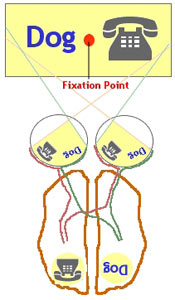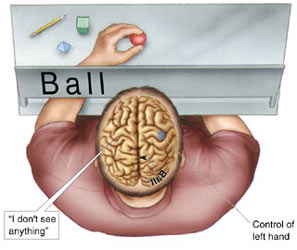Experiment Module: What Split Brains Tell
Us About Language
Communication between the two hemispheres of the brain is made possible by the bundles of axons, or commissures, that connect them. The largest of these bundles, known as the corpus callosum, consists of about 200 million axons running from one hemisphere to the other.
In the 1950s, American neuroscientist Roger Sperry and his team discovered that curiously enough, severing the corpus callosum in the brain of a cat or monkey had no notable effects on the animal’s behaviour. Only some special experimental protocols revealed that these animals were actually sometimes behaving as if they had two brains.
This absence of major deficits in animals with a severed corpus callosum gave neurosurgeons the idea of performing this operation on certain patients whose frequent, severe epileptic attacks were ruining their lives. In some of these patients, the epileptic focus was located in only one hemisphere, so this operation could successfully prevent the attacks from propagating to the other hemisphere. Having had this operation, these “split-brain” individuals could go back to enjoying their lives; as with the animals in Sperry’s experiments, their day-to-day behaviour was practically unaffected by the separation of their brains into two halves.
|
The renowned American neuropsychologist Michael Gazzaniga, who began his career working with Roger Sperry, has developed several devices for analyzing functional differences between the two hemispheres in split-brain patients. The idea behind these devices is to deliver stimuli in such a way that they reach only one hemisphere, and then to observe how this hemisphere manages to process these stimuli on its own. To study language, Gazzaniga asked his subjects to focus on a point at the centre of a screen. He then projected images, words, and phrases onto the screen, to the left or right of this point. By flashing these items quickly enough that the subjects’ eyes had no time to move, Gazzaniga was able to “talk” to just one of the hemispheres at a time. Information projected in the subjects’ left visual field was received by the right hemisphere, while information projected in the right visual field was received by the left. |  |
The subjects could easily repeat numbers or words or describe images projected in their right visual field, because the left hemisphere, which received and processed this information, is the dominant hemisphere for language. Similarly, when asked to close their eyes and feel an object with their right hand, they could describe the object readily.
But when the visual stimuli were projected in the subjects’ left visual field or when they were asked to feel objects with their left hand, their performance was quite different: they could not describe the stimuli or objects concerned. In fact, for the visual stimuli, they even said that they hadn’t seen anything at all!
Though the right hemisphere does have some serious gaps in its language-processing abilities, it is not completely devoid of them. It can read and understand numbers, letters, and short statements, so long as the individual does not have to demonstrate this understanding verbally.
| For example, if the name of an object is projected so that a subject with a severed corpus callosum sees it with the right hemisphere only, he will say that he doesn’t see anything, because the severed connection has in fact prevented his left hemisphere, which is dominant for language, from doing so. But if the experimenter then asks the subject to use his left hand to choose a card with a drawing of the object whose name he saw, or to identify this object by feeling it with his left hand, he will have no problem in performing the task. Thus the right hemisphere cannot express itself in complex sentences, but it clearly can recognize words. |  |
In another experiment, a photo of a naked man was presented to the right hemisphere of a female split-brain patient. When asked about the nature of the photo, she began to laugh and explained that she didn’t know why she was laughing, but that maybe it was because of the machine that was projecting the images.
| Certain experiments that Gazzaniga conducted with split-brain patients also led him to develop the concept of the “left-hemisphere interpreter”. In one of these classic experiments, the split-brain patient had to point with his two hands at pictures of two objects corresponding to two images that he had seen on the divided screen (one with each of his two separated hemispheres). In the test shown here, the patient’s left hand is pointing at the card with a picture of a snow shovel, because the right hemisphere, which controls this hand, has seen the projected image of a winter scene. Meanwhile, his right hand is pointing at the card with a picture of a chicken, because his left hemisphere has seen the image of a chicken’s foot. |  |
But when the patient is asked to explain why his left hand is pointing at the shovel, his talking hemisphere—the left one—has no access to the information seen by the right, and so instead interprets his behaviour by responding that the reason is that you use a shovel to clean out the chicken house! Experiments like this show just how ready the brain is to provide language-based explanations for behaviour.
Gazzaniga’s experiments
thus helped to demonstrate the lateralization of language as well as other functional
differences between the left and right hemispheres.
|
|
